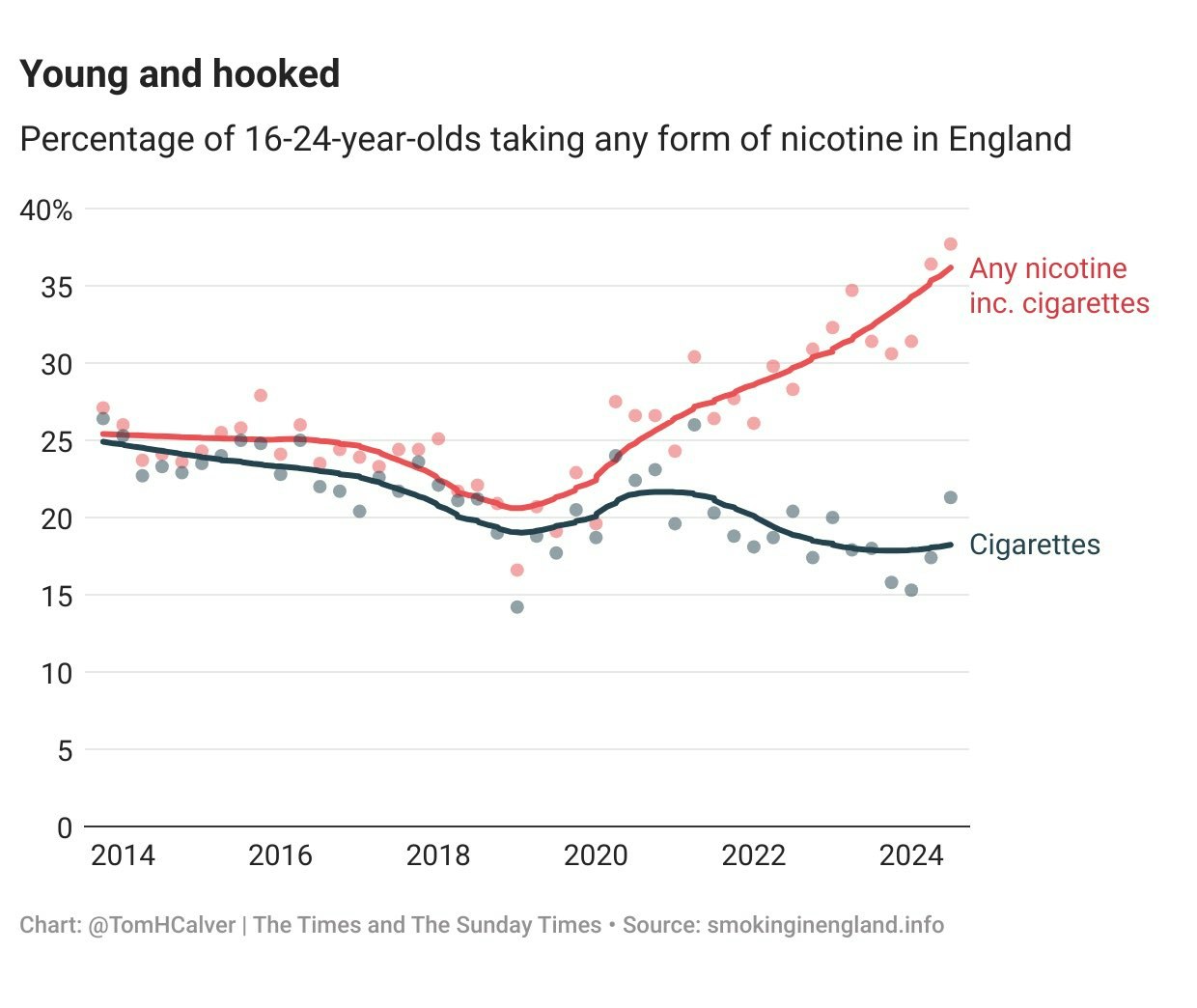Does vaping do more harm than good?
It seems improbable
Has vaping backfired? That is the question asked by Sunday Times journalist Tom Calver yesterday. He claims that rising e-cigarette use has left Britain with more nicotine users than it did when the smoking ban was introduced in 2007 and that nearly 40 per cent of 16-24 year olds are “hooked” on nicotine. This, he says, “might just about be tolerable if cigarette smoking rates were quickly falling. But they are not.” He even claims that there are “some signs that the number of young cigarette smokers is ticking back up again”.

Setting aside the question of whether Mr Calver’s view of what is “tolerable” is of any importance, the statistics he cites are striking, but it is difficult to reconcile them with official figures from the Office for National Statistics. The most recent set of ONS figures were published last month and they show that the smoking rate in Great Britain fell last year for the eleventh time in a row. The smoking rate has halved since vaping became mainstream in 2012 and currently stands at 10.5 per cent according to the ONS’s Annual Population Survey or 11.9 per cent according to its Opinions and Lifestyle Survey.
The ONS notes that “those aged 18 to 24 years have seen the largest reduction in smoking prevalence between 2011 (25.7%) and 2023 (9.8%)”. If we look at the 16-24 age group, which is the focus of the Sunday Times article, the ONS finds that the smoking rate was consistently above 20 per cent until 2016 but has since fallen to just 8 per cent, with most of the decline occurring after disposable vapes became popular in 2020.
Vaping has certainly taken off among 16-24 year olds in recent years. ONS figures indicate that e-cigarette use was confined to 1.4 per cent of this age group in 2014. By 2023, it had risen to 16 per cent, although most of them (9 per cent) were only occasional users. People who only use e-cigarettes occasionally are clearly not “hooked”, but even if we lump them in with the daily users and the smokers, this only gives us a figure of 24 per cent. That is lower than the smoking rate among the same age group in 2007.
But we can’t lump them together because, as Calver rightly points out, a lot of vapers are “dual users” who smoke as well. It is currently estimated that 4 in 10 vapers are also smokers, so to avoid double-counting we need to chop the vaping prevalence estimate down from 16 per cent to 10 per cent. Add this to the number of smokers (8 per cent) and the total prevalence of nicotine consumption among 16-24 year olds is not “nearly 40 per cent”, as Calver claims, but a mere 18 per cent.
Across the whole adult population, the ONS says that 9.8 per cent use e-cigarettes (including 4 per cent who do so occasionally) and 10.5 per cent smoke. Adjusting for dual use, the proportion of adults who inhale nicotine in some form is 16 per cent. That is lower than the smoking rate was before e-cigarettes came on the scene.
So where do Calver’s figures come from? He doesn’t use the official statistics and instead relies on the Smoking Toolkit Study which uses a monthly telephone survey to get estimates of smoking and vaping prevalence. The sample size is smaller than the ONS’s and there are a few other differences, notably that it focuses on England rather than Great Britain and includes pipe and cigar smokers as well as cigarette smokers, but this doesn’t seem to be enough to explain why its findings differ so much from the surveys used by the ONS.
The ONS figures show a clear and substantial downward trend in the smoking rate among all age groups since 2020 whereas the STS figures are higher and almost flat. The ONS says that 16 per cent of 16-24 year olds were vaping in 2023 whereas the STS has a figure of 24 per cent. These are significant differences and I can’t fully explain them. The STS doesn’t provide smoking prevalence figures for 16-24 years at all so it’s unclear how Calver arrived at his estimate for total nicotine consumption, but the STS’s estimate that 19 per cent of 18-21 year olds are smokers doesn’t seem compatible with the ONS’s estimate that only 8 per cent of 16-24 year olds smoke.
It all depends on which set of figures you believe. The STS figures broadly support Calver’s narrative, although one of the academics who works on the STS disagrees with his conclusion. One reason to favour the ONS’s figures is that the STS claims that the smoking rate has not fallen for four years and yet we have hard data showing that the number of cigarettes sold legally has dropped by 37 per cent over that period. I have previously argued that this is partly due to the growth of the black market, but it hard to believe that is the sole reason. Another reason to prefer the ONS is that it uses two separate surveys, both of them large and both of them showing the same trends.
It is possible that the Smoking Toolkit Study has picked up something that the ONS surveys have failed to notice. If so, the Sunday Times article is correct, at least in parts. But the chances are that the official statistics are accurate and the rise of vaping in Britain has been accompanied by a sharp decline in the smoking rate amongst all age groups and to a decline in the number of people “hooked” on nicotine too.
Enjoying The Critic online? It's even better in print
Try five issues of Britain’s most civilised magazine for £10
Subscribe













